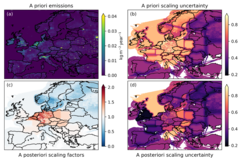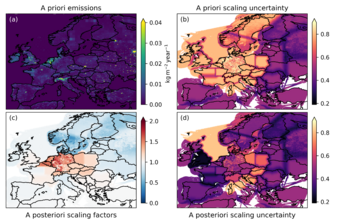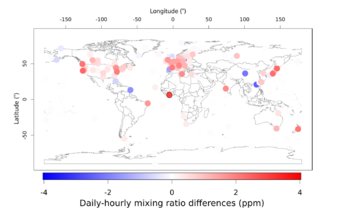Why the Daily CO₂ Cycle Matters for Climate Models
Effective climate policies require accurate carbon flux estimates, to inform emission reduction strategies and to support international agreements like the Paris Agreement. Munassar and colleagues showed in a recent study that overlooking the daily cycle of the biosphere’s “breathing” can lead to over- or underestimations in the regional carbon budgets as derived from inversion modelling.
Atmospheric inversions are a key tool for estimating where CO₂ is emitted (sources) and absorbed (sinks) by combining atmospheric CO₂ measurements with calculations of how air masses are transported through the atmosphere. These inversions estimate CO₂ carbon fluxes representing the balance between emissions and uptake, like for land biosphere processes (Net Ecosystem Exchange (NEE)). Since inversions depend not only on flux data but also on the accuracy of atmospheric transport models, capturing the movement of CO₂ in the atmosphere is crucial for understanding emissions and sinks at national, continental, and global scales.
Many inversion models use daily mean CO₂ flux values instead of capturing the full diurnal variation that occurs over vegetation. This simplification introduces systematic biases by smoothing out the strong daytime CO₂ uptake from photosynthesis as well as the nighttime CO₂ release from respiration. As a result, CO₂ flux estimates become distorted, particularly at regional and continental scales, where daily fluctuations differ significantly between land types. The problem becomes nonlinear because atmospheric transport responds differently depending on the timing of CO₂ uptake and release. In a linear system, an inversion based on daily mean fluxes would yield the same result as the daily mean of hourly inversions but this is not the case here, leading to further discrepancies. At the global scale, however, the overall impact on total annual flux estimates remains negligible because regional biases tend to cancel out due to mass conservation.
Building on this issue, Munassar et al. (2025) systematically quantified the effects of neglecting the diurnal cycle in global inversion models. By comparing inversion results based on hourly versus daily CO₂ fluxes, their study demonstrates how large the resulting regional biases can be and how these differences propagate into atmospheric CO₂ concentrations and carbon budgets. Figure 1 shows the differences between the annual flux budgets with and without correction for the diurnal cycle across different land regions across the globe. Negative differences, observed in e.g., Northern and Southern Africa and tropical Asia, indicate either an underestimation of CO₂ uptake or an overestimation of CO₂ release by inversions when the diurnal cycle in the flux is neglected. Positive differences, which can be seen, e.g., over Australia and Europe, imply that CO₂ sources are underestimated.

At regional and local scales, the impact is even more pronounced, with flux differences reaching up to 51%, depending on the region (not shown here). Neglecting the diurnal cycle also leads to different simulated atmospheric CO₂ mole fractions varying by -2.5 to +7 ppm (Fig. 2), leading to both overestimations and underestimations of CO₂ concentrations depending on geographical location and time of day.

CO₂ concentrations tend to be overestimated during the daytime, especially over land surfaces and at tall towers, continental sites, and surface monitoring stations. This is primarily because CO₂ is absorbed by vegetation during the day, and atmospheric transport models may fail to capture the rapid changes in fluxes that occur in response to daylight photosynthesis. In contrast, underestimations are more common at mountain stations during nighttime, as CO₂ from the land surface takes longer to mix into the atmosphere. These biases are particularly noticeable during the Northern Hemisphere’s growing season and can vary significantly from year to year, affecting the accurate assessment of long-term carbon flux trends. Failure to account for these discrepancies can introduce errors into CO₂ flux estimates, potentially leading to incorrect conclusions in climate research. Since carbon budgets are crucial for tracking emission reductions, inaccuracies in these calculations could have significant consequences for climate policy and carbon market mechanisms.
To improve the accuracy of CO₂ flux estimates, this study recommends using hourly flux data rather than daily averages whenever possible. If temporal high-resolution data are unavailable, correction factors should be applied. Additionally, atmospheric transport models should be evaluated to examine their ability in representing diurnal variability in land-atmosphere CO₂ exchanges.
Article By:
Saqr Munassar, Jennifer Müller-Williams and Elena Zwerschke

